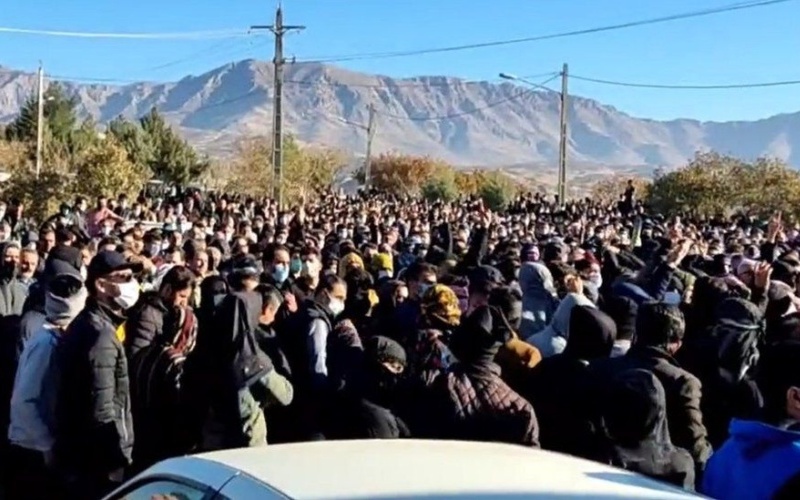Mourners at a funeral for two slain protesters in Javanrud, Kermanshah Province, northwest Iran, November 2022 (Hengaw)
I joined Beverley O’Connor of the Australian Broadcasting Corporation’s The World on Thursday to analyze the 10-week nationwide protests in Iran and why they are persisting despite the regime’s attempt to crush them through mass detentions, cutoff of communications, and the killing of more than 400 people.
I discuss the significance of today’s urgent session of the UN Human Rights Council and a resolution for an investigation of the crackdown.
I consider the difference between these protests and those in 2009 after the disputed Presidential election.
This time the regime is finding it more difficult to suppress the protests because they don’t have leaders, a single political figure whom authorities can put away and take the steam out of the demonstrations.
See also Iran’s Hijab Protests Challenge Legitimacy of A Weakened Regime
I look at the significance of the cross-section of Iranians — from World Cup footballers to filmmakers to educators to lawyers — supporting the protests, and I evaluate if the regime could consider steps to dialogue with the protesters about the issue they are raising.
You have some within the regime who are thinking, “We have got to find some middle ground.” But you have others — especially in the Supreme Leader’s office — who think that any discussions with the protesters show weakness.
We also consider another possible crisis, with Turkish President Recep Tayyip Erdoğan threatening the renewal of cross-border military operations into northern Syria.


Iran’s representative to the Human Rights Council rebukes decision to target Iran: https://www.unognewsroom.org/story/en/1557/islamic-republic-of-iran-statement-to-hrc
BBC and Queiroz over political situation in Iran: https://www.bbc.co.uk/news/av/world-middle-east-63750753
According to HRA: https://docs.google.com/document/d/1h5-7GfUpi3RHjwKCNCp-bhVpuiYtUEc4kjWRGW5ZM9Y/edit#
The number of protesting cities in the last 24 hours: 6
The number of protesting universities in the last 24 hours: 4
[Editor’s Note: The Cradle, established by the “anti-imperialist” propagandist Sharmine Narwani, is prominent in its support of lines put out by the Assad and Iranian regimes and the Kremlin.]
A war of narratives: Who killed the child in Iran’s Izeh?: https://thecradle.co/Article/Analysis/18732
Misinformation is rife. The central problem with the claim made by the opposition is the lack of a motive for Kian’s killing. The police or Baseej had no reason to shoot at the car he was in – unless they suspected it was used by rioters and armed gunmen (as seen on CCTV)
Mahsa Amini died because she wasn’t wearing her hijab correctly. Protests started because people were upset at injustice she suffered, they see it could be them next time. And then people looked at their own lives, they realize there is no future to look forward to. That is why you hear “we have nothing to lose”. Ten weeks on people want it ALL, it is no longer about scarps of hijab freedom.
The UN human right votes to investigate the human right abuse in iri:
https://www.radiofarda.com/a/32042577.html
https://twitter.com/UN_HRC/status/1595802214441910272?ref_src=twsrc%5Etfw%7Ctwcamp%5Etweetembed%7Ctwterm%5E1595802214441910272%7Ctwgr%5E54fda8bd524b420ac36a1a739c3a0365b542a20f%7Ctwcon%5Es1_&ref_url=https%3A%2F%2Fwww.radiofarda.com%2Fa%2F32042577.html
[Editor’s Note: A majority of Human Rights Council members *did* support the resolution. The vote was 25-6 with 16 abstentions.]
6 voted against and 16 abstained. Nations representing the majority of the world’s population did not approve this. The “Marshall islands” were among those who voted yes.